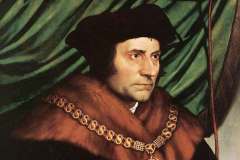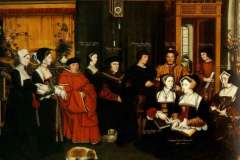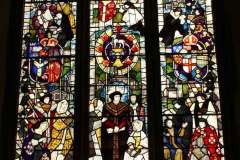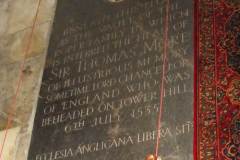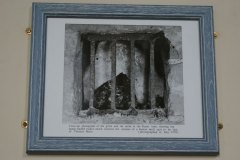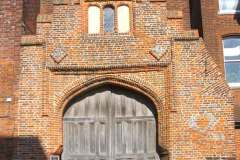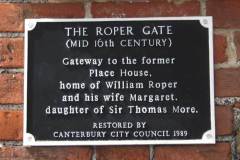Lord Chancellor, Chancellor of the Duchy of Lancaster, Speaker of the House of Commons
Introduction
Sir Thomas More (Image 1) was a lawyer, philosopher, humanist, author, statesman and counsellor to Henry VIII who rose to be Lord Chancellor, Chancellor of the Duchy of Lancaster and Speaker of the House of Commons. As an author he coined the term “Utopia” to describe an ideal world. He opposed the divorce of King Henry VIII from Catherine of Aragon and refused to recognise the King as head of the Church of England as required in the 1534 Act of Supremacy. He was beheaded at the Tower of London in 1535 for his refusal. He was canonised by the Catholic church in 1935 and recognised as “a saint and hero of the Christian Church” by the Church of England in 1980. He is also known as ”A Man for all Seasons” from the title of a 1960’s play by Robert Bolt about his life, which reflected his broad appeal to a wide spectrum of political, social and religious interests.
Canterbury Links
He had very few associations with Canterbury during his lifetime, but his inclusion is justified by one after his death :-
- He started his career as a page in the service of Archbishop Morton from 1492-94.
- He attended Canterbury College, Oxford (now incorporated into Christchurch) from 1494-96, but left early to start his legal training at New Inn Court.
- He must have passed through Canterbury on his missions to the continent on behalf of the King. He is only recorded as definitely visiting Canterbury twice. The first is with the King’s party who met the Emperor Charles V here on the way to meet King Francis I of France at the “Cloth of Field of Gold” in 1520. The second is with Cardinal Wolsey’s party on the way to Rome to seek agreement for the King’s divorce from Catherine of Aragon from the Pope in 1527.
- In 1533 he was involved in the affair of the Elizabeth Barton, “the Maid of Kent”, who simulated religious hysteria during which she predicted the downfall of Henry VIII, leading to her being beheaded for treason. Thomas More corresponded with her but escaped the similar fate that befell others who did so.
- He was beheaded on 6 July 1535, the eve of anniversary of the translation of St Thomas Becket to his shrine in the Trinity chapel at Canterbury Cathedral, implying in his final letter to his daughter Margaret that they both died for the freedom of the church.
- His daughter Margaret (Image 2), who had married William Roper of Canterbury, allegedly recovered his parboiled head from a spike at the Tower of London following his beheading. It was eventually buried with her in the Roper vault at St. Dunstan’s church in 1577. Later the vault was enlarged and the skull transferred to a niche behind a grille where it remains to this day, last seen during an investigation in 1978.
What to see
- In St. Dunstan’s church a 1973 window in the Roper chapel depicting events in his life (Image 3), a memorial slab (Image 4) and a considerable amount of information on his life and death, including a picture of the skull in a niche of the vault below (Image 5).
- Across St. Dunstan’s Street from the church a plaque (Image 7) commemorating the family’s association with Thomas More is mounted on the Roper Gate (Image 6).
Access: St. Dunstan’s church is normally open during daylight hours and the external facade of the Roper Gate is accessible at all times.
Sources: Albin (1994): Tatton-Brown (1980) https://thomasmorestudies.org/
SR

